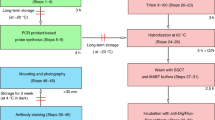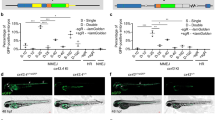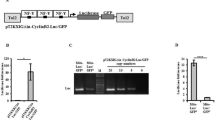Abstract
The zebrafish has many advantages as a vertebrate model organism and has been extensively used in the studies of development. Its potential as a model in which to study tumour suppressor and oncogene function is now being realized. Whilst in situ hybridization of mRNA has been well developed in this species to study gene expression, antibody probes are in short supply. We have, therefore, generated a panel of anti-zebrafish p53 monoclonal antibodies and used these to study the p53 response in zebrafish embryos. By immunohistochemistry, we show that the exposure of zebrafish embryos to p53-activating agents such as R-roscovitine and γ-irradiation results in the accumulation of p53 protein in the gut epithelium, liver and pancreas. A combination of R-roscovitine and γ-irradiation results in massive p53 induction, not only in the pharyngeal arches, gut region and liver but also in brain tissues. Induction of apoptosis and expression of p53 response genes are seen in regions that correspond to sites of p53 protein accumulation. In contrast, although zebrafish tp53M214K mutant embryos showed a similar accumulation of p53 protein, a complete lack of a downstream p53-dependent response was observed. In this system the p53 gene is identified as a p53-responsive gene itself. Our results demonstrate that zebrafish p53 protein can readily be induced in embryos and detected using these new antibody tools, which will increase the usefulness of zebrafish as a model in compound-based screening for novel drugs in cancer research.
This is a preview of subscription content, access via your institution
Access options
Subscribe to this journal
Receive 50 print issues and online access
$259.00 per year
only $5.18 per issue
Buy this article
- Purchase on Springer Link
- Instant access to full article PDF
Prices may be subject to local taxes which are calculated during checkout








Similar content being viewed by others
References
Alarcon-Vargas D, Ronai Z . (2002). p53-Mdm2—the affair that never ends. Carcinogenesis 23: 541–547.
Ball KL . (1997). p21: structure and functions associated with cyclin-CDK binding. Prog Cell Cycle Res 3: 125–134.
Bartek J, Iggo R, Gannon J, Lane DP . (1990). Genetic and immunochemical analysis of mutant p53 in human breast cancer cell lines. Oncogene 5: 893–899.
Berghmans S, Murphey RD, Wienholds E, Neuberg D, Kutok JL, Fletcher CD et al. (2005). tp53 mutant zebrafish develop malignant peripheral nerve sheath tumors. Proc Natl Acad Sci USA 102: 407–412.
Chen J, Ruan H, Ng SM, Gao C, Soo HM, Wu W et al. (2005). Loss of function of def selectively up-regulates Delta113p53 expression to arrest expansion growth of digestive organs in zebrafish. Genes Dev 19: 2900–2911.
Cheng R, Ford BL, O’Neal PE, Matthews CZ, Bradford CS, Thongtan T et al. (1997). Zebrafish (Danio rerio) p53 tumour suppressor gene: cDNA sequence and expression during embryogenesis. Mol Mar Biol Biotechnol 6: 88–97.
Cho Y, Gorina S, Jeffrey PD, Pavletich NP . (1994). Crystal structure of a p53 tumor suppressor-DNA complex: understanding tumorigenic mutations. Science 265: 346–355.
Gannon JV, Greaves R, Iggo R, Lane DP . (1990). Activating mutations in p53 produce a common conformation effect. A monoclonal antibody specific for the mutant form. EMBO J 9: 1595–1602.
Greenblatt MS, Bennett WB, Hollstein M, Harris CC . (1994). Mutations in the p53 tumour suppressor gene: clues to cancer etiology and molecular pathogenesis. Cancer Res 54: 4855–4878.
Harlow E, Lane DP . (1988). Antibodies: A Laboratory Manual. Cold Spring Harbor Laboratory Press: Cold Spring Harbor, New York, pp 186–187.
Harlow E, Lane DP . (1999). Using Antibodies: A Laboratory Manual. Cold Spring Harbor Laboratory Press: Cold Spring Harbor, New York, pp 395–396.
Hollstein M, Sidransky D, Vogelstein B, Harris CC . (1991). p53 mutations in human cancers. Science 253: 49–53.
Jin S, Martinek S, Joo WS, Wortman JR, Mirkovic N, Sali A et al. (2000). Identification and characterization of a p53 homologue in Drosophila melanogaster. Proc Natl Acad Sci USA 97: 7301–7306.
Jowett T . (1999). Analysis of protein and gene expression. Methods Cell Biol 59: 63–84.
Kastan MB, Onyekwere O, Sidransky D, Vogelstein B, Craig RW . (1991). Participation of p53 protein in the cellular response to DNA damage. Cancer Res 51: 6304–6311.
Kimmel CB, Ballard WW, Kimmel SR, Ullmann B, Schilling TF . (1995). Stages of embryonic development of the zebrafish. Dev Dyn 203: 253–310.
Kotala V, Uldrijan S, Horky M, Trbusek M, Strnad M, Vojtesek B . (2001). Potent induction of wild-type p53-dependent transcription in tumour cells by a synthetic inhibitor of cyclin-dependent kinases. Cell Mol Life Sci 58: 1333–1339.
Laemmli UK . (1970). Cleavage of structural proteins during the assembly of the head of bacteriophage T4. Nature 227: 680–685.
Lang GA, Iwakuma T, Suh YA, Liu G, Rao VA, Parant JM et al. (2004). Gain of function of a p53 hot spot mutation in a mouse model of Li-Fraumeni syndrome. Cell 119: 861–872.
Langheinrich U, Hennen E, Stott G, Vacun G . (2002). Zebrafish as a model organism for the identification and characterization of drugs and genes affecting p53 signaling. Curr Biol 12: 2023–2028.
Levine AJ, Momand J, Finlay CA . (1991). The p53 tumour suppressor gene. Nature 351: 453–456.
Lu W, Chen L, Peng Y, Chen J . (2001). Activation of p53 by roscovitine-mediated suppression of MDM2 expression. Oncogene 20: 3206–3216.
Midgley CA, Owens B, Briscoe CV, Thomas DB, Lane DP, Hall PA . (1995). Coupling between gamma irradiation, p53 induction and the apoptotic response depends upon cell type in vivo. J Cell Sci 108: 1843–1848.
Mitsudomi T, Steinberg SM, Nau MM, Carbone D, D’Amico D, Bodner S et al. (1992). p53 gene mutations in non-small-cell lung cancer cell lines and their correlation with the presence of ras mutations and clinical features. Oncogene 7: 171–180.
Nickels A, Selter H, Pfreundschuh M, Montenarh M, Koch B . (1997). Detection of p53 in inflammatory tissue and lymphocytes using immunohistology and flow cytometry: a critical comment. J Clin Pathol 50: 654–660.
Nusslein-Volhard C, Dahm R . (2002). Zebrafish: A Practical Approach. Oxford University Press Inc.: New York.
Olive KP, Tuveson DA, Ruhe ZC, Yin B, Willis NA, Bronson RT et al. (2004). Mutant p53 gain of function in two mouse models of Li-Fraumeni syndrome. Cell 119: 847–860.
Olivier M, Eeles R, Hollstein M, Khan MA, Harris CC, Hainaut P . (2002). The IARC TP53 database: new online mutation analysis and recommendations to users. Hum Mutat 19: 607–614.
Oren M . (1985). The p53 cellular tumor antigen: gene structure, expression and protein properties. Biochim Biophys Acta 823: 67–78.
Patton EE, Widlund HR, Kutok JL, Kopani KR, Amatruda JF, Murphey RD et al. (2005). BRAF mutations are sufficient to promote nevi formation and cooperate with p53 in the genesis of melanoma. Curr Biol 15: 249–254.
Reed JC . (1999). Dysregulation of apoptosis in cancer. J Clin Oncol 17: 2941–2953.
Ribas J, Boix J, Meijer L . (2006). (R)-roscovitine (CYC202, Seliciclib) sensitizes SH-SY5Y neuroblastoma cells to nutlin-3-induced apoptosis. Exp Cell Res 312: 2394–2400.
Soussi T, May P . (1996). Structural aspects of the p53 protein in relation to gene evolution: a second look. J Mol Biol 260: 623–637.
Spitsbergen JM, Kent ML . (2003). The state of the art of the zebrafish model for toxicology and toxicologic pathology research—advantages and current limitations. Toxicol Pathol 31 (Suppl): 62–87.
Spitsbergen JM, Tsai HW, Reddy A, Miller T, Arbogast D, Hendricks JD et al. (2000). Neoplasia in zebrafish (Danio rerio) treated with N-methyl-N′-nitro-N-nitrosoguanidine by three exposure routes at different developmental stages. Toxicol Pathol 28: 716–725.
Stanton M . (1965). Diethylnitrosamine-induced hepatic degeneration and neoplasia in the aquarium fish Brachydario rerio. J Natl Cancer Inst 34: 117–130.
Stern HM, Zon LI . (2003). Cancer genetics and drug discovery in the zebrafish. Nature Rev 3: 1–7.
Sutcliffe JE, Brehm A . (2004). Of flies and men; p53, a tumour suppressor. FEBS Lett 567: 86–91.
Thisse C, Neel H, Thisse B, Daujat S, Piette J . (2000). The Mdm2 gene of zebrafish (Danio rerio): preferential expression during development of neural and muscular tissues, and absence of tumor formation after overexpression of its cDNA during early embryogenesis. Differentiation 66: 61–70.
Vassilev LT, Vu BT, Graves B, Carvajal D, Podlaski F, Filipovic Z et al. (2004). In vivo activation of the p53 pathway by small-molecule antagonists of MDM2. Science 303: 844–848.
Zhao L, Samuels T, Winckler S, Korgaonkar C, Tompkins V, Horne MC et al. (2003). Cyclin G1 has growth inhibitory activity linked to the ARF-Mdm2-p53 and pRb tumor suppressor pathways. Mol Cancer Res 1: 195–206.
Acknowledgements
We thank Dr Hwang Le-Ann from the Monoclonal Antibody Unit at the Institute of Molecular and Cell Biology for assistance in screening the hybridoma clones. The pCS-myc-Zp53 plasmid was a generous gift from Dr Jacques Piette (Centre de Recherche en Cancérologie, France). The zebrafish tp53M214K mutant line was kindly provided by Professor A Thomas Look (Dana-Farber Cancer Institute, USA). Zebrafish embryos were processed and sectioned by the Biopolis Shared Facility Histology unit. Professor David Lane is a Gibb Fellow of Cancer Research UK. This work was supported by the BioMedical Research Council of Singapore.
Author information
Authors and Affiliations
Corresponding author
Rights and permissions
About this article
Cite this article
Lee, KC., Goh, W., Xu, M. et al. Detection of the p53 response in zebrafish embryos using new monoclonal antibodies. Oncogene 27, 629–640 (2008). https://doi.org/10.1038/sj.onc.1210695
Received:
Revised:
Accepted:
Published:
Issue Date:
DOI: https://doi.org/10.1038/sj.onc.1210695
Keywords
This article is cited by
-
Co-exposure to environmental carcinogens in vivo induces neoplasia-related hallmarks in low-genotoxicity events, even after removal of insult
Scientific Reports (2018)
-
The use of the NEDD8 inhibitor MLN4924 (Pevonedistat) in a cyclotherapy approach to protect wild-type p53 cells from MLN4924 induced toxicity
Scientific Reports (2016)
-
Identification of p53-target genes in Danio rerio
Scientific Reports (2016)
-
Tumor-specific signaling to p53 is mimicked by Mdm2 inactivation in zebrafish: insights from mdm2 and mdm4 mutant zebrafish
Oncogene (2015)
-
Activation of Sonic hedgehog signaling in neural progenitor cells promotes glioma development in the zebrafish optic pathway
Oncogenesis (2014)



